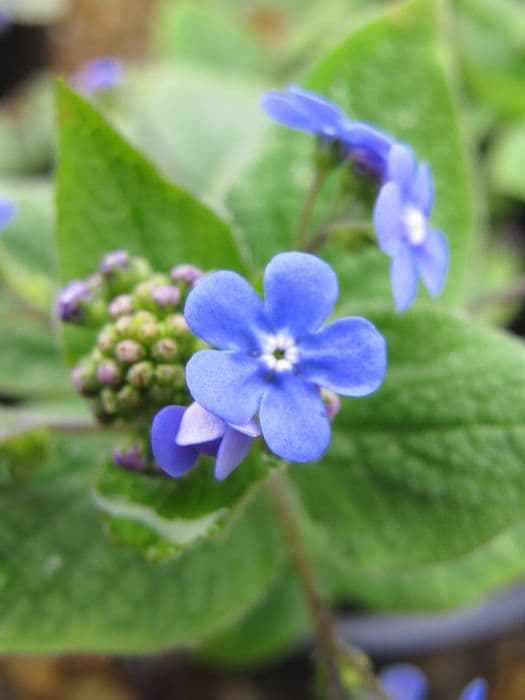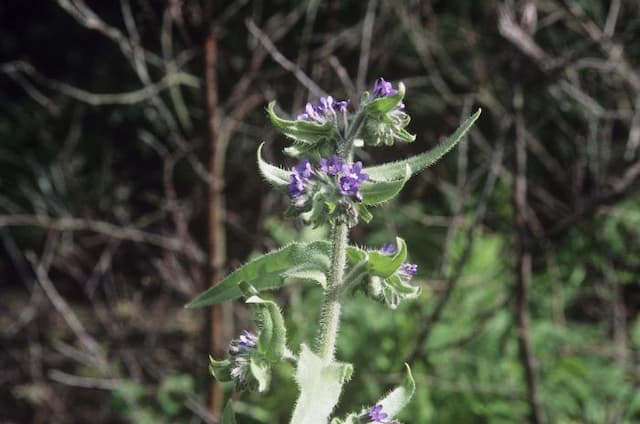Siberian bugloss 'Langtrees' Brunnera macrophylla 'Langtrees'

ABOUT
'Langtrees' is a deciduous perennial with sprays of dainty, forget-me-not blue flowers in spring above rough-textured, heart-shaped leaves. These bear an outer ring of metallic grey markings
About this plant
 Names
NamesFamily
Boraginaceae.
Synonyms
Siberian Bugloss, False Forget-Me-Not, Heartleaf Brunnera, Heartleaf Bugloss, Langtrees Silverleaf.
Common names
Brunnera macrophylla 'Langtrees'.
 Characteristics
CharacteristicsLife cycle
Perennials
Foliage type
Deciduous
Color of leaves
Variegated
Flower color
Blue
Height
1-1.5 feet (30-45 cm)
Spread
1-1.5 feet (30-45 cm)
Plant type
Herb
Hardiness zones
3
Native area
Caucasus
Benefits
 General Benefits
General Benefits- Ornamental Appeal: Brunnera macrophylla 'Langtrees', commonly known as Siberian Bugloss, boasts attractive heart-shaped leaves and delicate blue flowers that enhance garden aesthetics.
- Shade Tolerance: This variety thrives in shady areas where other plants may struggle, making it ideal for woodland gardens and shaded borders.
- Low Maintenance: Siberian Bugloss requires minimal care once established, making it suitable for gardeners of all skill levels.
- Seasonal Interest: Provides early spring blooms and maintains leaf interest throughout the summer and into the fall.
- Attracts Wildlife: The flowers of Siberian Bugloss attract pollinators such as bees, providing support for local ecosystems.
- Drought Resistance: Once established, it can tolerate periods of drought, reducing the need for frequent watering.
- Pest Resistance: This plant is generally resistant to pests and diseases, which can minimize the need for chemical treatments.
- Soil Versatility: It can grow in a range of soil types, though it prefers well-drained soil, making it adaptable to different garden conditions.
- Natural Ground Cover: Dense foliage helps suppress weeds and can provide a natural and decorative ground cover.
- Cold Hardy: Siberian Bugloss is capable of surviving in colder climates, making it suitable for gardens in temperate zones.
 Medical Properties
Medical PropertiesThis plant is not used for medical purposes.
 Air-purifying Qualities
Air-purifying QualitiesThis plant is not specifically known for air purifying qualities.
 Other Uses
Other Uses- Leaf Printing: The large leaves of Siberian Bugloss can be coated with paint and pressed onto paper to create natural art prints.
- Natural Dyes: The foliage and flowers can sometimes be used to produce natural dyes for fabrics or crafting purposes.
- Fairy Gardens: Being a smaller plant with attractive foliage, Siberian Bugloss can be used in fairy gardens to add texture and interest.
- Photography Backgrounds: Its dense foliage and flowers provide a lush background for photographing insects and other small wildlife.
- Educational Tool: Gardeners and educators can use Siberian Bugloss to teach about native and shade-tolerant plant species.
- Border Plants: Their tidy growth habit makes them suitable for use as a subtly decorative border in garden beds and walkways.
- Culinary Garnish: Although not widely known for its culinary uses, the small blooms can occasionally be used as an edible garnish for salads and desserts.
- Companion Planting: Siberian Bugloss can be planted alongside other shade-loving plants as part of a companion planning strategy to optimize garden space.
- Leaf Castings: The textured leaves can be used to make decorative leaf castings in concrete or plaster for ornamental garden features.
- Ikebana: The Japanese art of flower arranging, ikebana, can incorporate Siberian Bugloss for its interesting foliage and delicate blooms.
Interesting Facts
 Feng Shui
Feng ShuiThe Siberian bugloss is not used in Feng Shui practice.
 Zodiac Sign Compitability
Zodiac Sign CompitabilityThe Siberian bugloss is not used in astrology practice.
 Plant Symbolism
Plant Symbolism- Endurance: Brunnera macrophylla 'Langtrees', commonly known as Siberian Bugloss, can thrive in the shaded areas of a garden, symbolizing the ability to endure and prosper despite challenging conditions.
- Perseverance: Its ability to grow and spread, even in the competitive environment under trees, represents tenacity and the determination to grow, akin to overcoming life's obstacles.
- Loyalty: With its heart-shaped leaves, Siberian Bugloss is often associated with loyalty and faithfulness in relationships, similar to how the plant remains robust in its perennial nature.
 Water
WaterFor Siberian Bugloss (Brunnera macrophylla 'Langtrees'), water deeply once a week, ensuring the soil is moist but not waterlogged. During hotter periods or in warmer climates, increase the frequency to two times per week. Each watering session should consist of at least one gallon of water for mature plants, allowing the moisture to penetrate the root zone. In the winter, reduce watering as the plant's growth slows down and only water when the topsoil feels dry to the touch.
 Light
LightSiberian Bugloss thrives in partial to full shade, avoiding direct afternoon sun which can scorch its leaves. A spot under a canopy of trees or on the north side of a building where it can receive dappled sunlight is ideal, ensuring it gets bright but indirect light.
 Temperature
TemperatureSiberian Bugloss prefers a cool to moderate temperature range, ideally between 50°F and 75°F. It can survive temporary dips down to 20°F but may suffer if temperatures fall below this. Conversely, temperatures above 80°F may stress the plant and require additional shade and watering to maintain its health.
 Pruning
PruningPrune Siberian Bugloss to remove spent flower stalks and encourage a second bloom. Light pruning can be done after the first flowering in late spring or early summer. Cut the plant back significantly in the fall to promote healthy growth the following season and to maintain a tidy appearance.
 Cleaning
CleaningAs needed
 Soil
SoilSiberian Bugloss 'Langtrees' thrives best in a soil mix that is rich, moist, and well-draining, with plenty of organic matter such as compost or leaf mold to retain moisture. The ideal pH range for this plant is slightly acidic to neutral, around 5.5 to 7.0. To create the best soil mix, combine garden soil, compost, peat, and perlite in equal parts for aeration and water retention.
 Repotting
RepottingSiberian Bugloss 'Langtrees' does not typically require frequent repotting as it is mostly grown as a perennial outdoor plant. However, if grown in containers, repotting may be done every 2-3 years to refresh the soil and accommodate root growth. When repotting, choose a slightly larger pot to provide space for roots to spread.
 Humidity & Misting
Humidity & MistingSiberian Bugloss 'Langtrees' is adaptable to a wide range of humidity levels but prefers a moderately humid environment similar to its natural woodland habitat. Strive for a humidity level of 40-60%, which will generally be adequate without needing special attention to humidity conditions.
 Suitable locations
Suitable locationsIndoor
Keep Siberian Bugloss in shaded area with moist soil indoors.
Outdoor
Plant in partial shade with moist, rich soil outdoors.
Hardiness zone
3-8 USDA.
 Life cycle
Life cycleBrunnera macrophyylla 'Langtrees', commonly known as Siberian bugloss, begins its life cycle as a seed, which germinates in favorable conditions of moisture and temperature. After germination, seedlings emerge, developing a rosette of basal leaves as they mature into juvenile plants. The plant establishes a robust root system and produces distinctive heart-shaped, silver-spotted leaves as it enters the vegetative growth stage. Siberian bugloss normally blooms in early to mid-spring, displaying clusters of tiny, sky-blue flowers akin to those of the forget-me-nots. After pollination, it develops seed capsules that release seeds to complete the cycle. In winter, the plant may die back, especially in colder climates, but it is a herbaceous perennial, so it will emerge again from its strong rootstock the following spring.
 Propogation
PropogationPropogation time
Early spring
The most common method of propagating Brunnera macrophylla 'Langtrees', commonly known as Siberian bugloss, is by division. This is best done in the spring as new growth begins. To propagate by division, carefully dig up the plant and gently separate the clumps into smaller sections, ensuring that each new piece has a portion of the root system attached. These sections can then be immediately replanted in moist, well-drained soil, maintaining the same depth at which they were originally growing. Water the newly planted divisions well to help establish them. It is crucial to keep the soil consistently moist, but not waterlogged, during the first growing season to ensure successful establishment.









